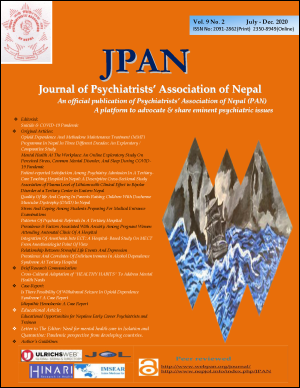Patient-reported Satisfaction Among Psychiatry Admission In A Tertiary-Care Teaching Hospital In Nepal: A Descriptive Cross-Sectional Study
DOI:
https://doi.org/10.3126/jpan.v9i2.36280Keywords:
Psychiatric Inpatients, Satisfaction, Treatment, Mental IllnessAbstract
Introduction: Satisfaction among the patients reflects the quality of care provided. Patient demographics, diagnosis, and chronicity of illness, institutional, and/or medical factors have been found as contributing factors in different studies. This study aims to evaluate the satisfaction among psychiatric inpatients in a tertiary care center.
Material and Method: This was a descriptive cross-sectional study on the inpatients at the Department of Psychiatry of a tertiary care` teaching hospital in Nepal during a one-year study period from May 2015 to June 2016. We interviewed the inpatients at the time of discharge and collected data on the demographic and clinical characteristics, the satisfaction of treatment received, and sought any suggestions to improve the services. We summarized the numerical variables with the median and inter-quartile range (IQR) and the categorical variables as proportion.
Results: Of the 286 patients admitted during the study period, 122 patients responded (42.6%). The median age was 32 years (IQR 22-43) and the majority were male (73, 59.8%), married (78, 63.9%), skilled labor or student (26, 21.3%) by occupation, and had secondary level education (31, 25.4%). Most of the patients reported satisfaction (115, 94.2%) with the care received. Among the different domains of satisfaction, most positive responses were seen in the treatment (116, 95.08%) and the least in the treatment cost (57, 46.7%). Suggestions on the improvement of infrastructure of the ward and subsidy in the treatment cost were received.
Conclusion: Most of the inpatients reported satisfaction with the care they received. Further exploration into different domains of satisfaction is needed.
Downloads
Downloads
Published
How to Cite
Issue
Section
License
This license enables reusers to distribute, remix, adapt, and build upon the material in any medium or format, so long as attribution is given to the creator. The license allows for commercial use.




